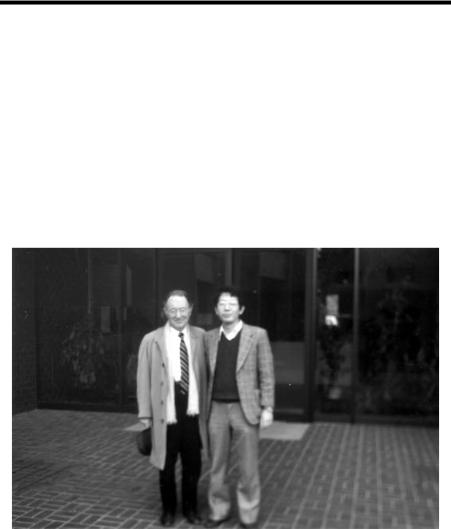
The Nitro group in organic sysnthesis - Feuer
.pdfThe Nitro Group in Organic Synthesis. Noboru Ono Copyright © 2001 Wiley-VCH ISBNs: 0-471-31611-3 (Hardback); 0-471-22448-0 (Electronic)
THE NITRO GROUP IN ORGANIC SYNTHESIS
ORGANIC NITRO CHEMISTRY SERIES
Managing Editor
Dr. Henry Feuer
Purdue University
West Lafayette, Indiana 47907
USA
|
EDITORIAL BOARD |
Hans H. Baer |
George Olah |
Ottawa, Canada |
Los Angeles, CA, USA |
Robert G. Coombes |
Noboru Ono |
London, England |
Matsuyama, Japan |
Leonid T. Eremenko |
C.N.R Rao |
Chernogolovka, Russia |
Bangalore, India |
Milton B. Frankel |
John H. Ridd |
Canoga Park, CA, USA |
London, England |
Philip C. Myhre |
Dieter Seebach |
Claremont, CA, USA |
Zurich, Switzerland |
Arnold T. Nielsen |
François Terrier |
China Lake, CA, USA |
Rouen, France |
Wayland E. Noland |
Heinz G. Viehe |
Minneapolis, MN, USA |
Louvain-la-Neuve, Belgium |
Also in the Series:
Nitroazoles: The C-Nitro Derivatives of Five-Membered N- and N,O-Heterocycles by Joseph H. Boyer
Nitrile Oxides, Nitrones, and Nitronates in Organic Synthesis: Novel Strategies in Synthesis by Kurt B.G. Torssell
Nitro Compounds: Recent Advances in Synthesis and Chemistry
Edited by Henry Feuer and Arnold T. Nielsen
Nitration: Methods and Mechanisms
by George A. Olah, Ripudaman Malhotra, and Sabhash C. Narong
Nucleophilic Aromatic Displacement: The Influence of the Nitro Group by François Terrier
Nitrocarbons
by Arnold T. Nielsen

THE NITRO GROUP IN ORGANIC SYNTHESIS
Noboru Ono
A JOHN WILEY & SONS, INC., PUBLICATION
New York  Chichester
Chichester  Weinheim
Weinheim  Brisbane
Brisbane  Singapore
Singapore  Toronto
Toronto
Designations used by companies to distinguish their products are often claimed as trademarks. In all instances where John Wiley & Sons, Inc., is aware of a claim, the product names appear in initial capital or ALL CAPITAL LETTERS. Readers, however, should contact the appropriate companies for more complete information regarding trademarks and registration.
Copyright © 2001 by Wiley-VCH. All rights reserved.
No part of this publication may be reproduced, stored in a retrieval system or transmitted in any form or by any means, electronic or mechanical, including uploading, downloading, printing, decompiling, recording or otherwise, except as permitted under Sections 107 or 108 of the 1976 United States Copyright Act, without the prior written permission of the Publisher. Requests to the Publisher for permission should be addressed to the Permissions Department, John Wiley & Sons, Inc., 605 Third Avenue, New York, NY 10158-0012, (212) 850-6011, fax (212) 850-6008, E-Mail: PERMREQ @ WILEY.COM.
This publication is designed to provide accurate and authoritative information in regard to the subject matter covered. It is sold with the understanding that the publisher is not engaged in rendering professional services. If professional advice or other expert assistance is required, the services of a competent professional person should be sought.
ISBN 0-471-22448-0
This title is also available in print as ISBN 0-471-31611-3.
For more information about Wiley products, visit our web site at www.Wiley.com.

CONTENTS
Series Foreword |
ix |
|
Preface |
xi |
|
Acknowledgments |
xiii |
|
Abbreviations |
xv |
|
1. |
Introduction |
1 |
2. |
Preparation of Nitro Compounds |
3 |
2.1Nitration of Hydrocarbons / 3
2.1.1Aromatic Compounds / 3
2.1.2Alkanes / 7
2.1.3Activated C-H Compounds / 10
2.1.4Alkenes / 11
2.1.5Synthesis of =-Nitro Ketones / 16
2.1.6Nitration of Alkyl Halides / 17
2.2Synthesis of Nitro Compounds by Oxidation / 20
2.2.1Oxidation of Amines / 20
2.2.2Oxidation of Oximes / 21
3. The Nitro-Aldol (Henry) Reaction |
30 |
3.1Preparation of β-Nitro Alcohols / 31
3.2Derivatives from β-Nitro Alcohols / 38
3.2.1Nitroalkenes / 38
3.2.2Nitroalkanes / 44
3.2.3=-Nitro Ketones / 46
3.2.4>-Amino Alcohols / 48
3.2.5Nitro Sugars and Amino Sugars / 48
3.3Stereoselective Henry Reactions and Applications to Organic Synthesis / 51
4. Michael Addition |
70 |
4.1 Addition to Nitroalkenes / 70
v
viCONTENTS
4.1.1Conjugate Addition of Heteroatom-Centered Nucleophiles / 70
4.1.2Conjugate Addition of Heteroatom Nucleophiles and Subsequent Nef Reaction / 80
4.1.3Conjugate Addition of Carbon-Centered Nucleophiles / 85
4.2Addition and Elimination Reaction of β-Heterosubstituted Nitroalkenes / 100
4.3Michael Addition of Nitroalkanes / 103
4.3.1Intermolecular Addition / 103
4.3.2Intramolecular Addition / 113
4.4Asymmetric Michael Addition / 115
4.4.1Chiral Alkenes and Chiral Nitro Compounds / 115
4.4.2Chiral Catalysts / 118
5. Alkylation, Acylation, and Halogenation of Nitro Compounds |
126 |
5.1Alkylation of Nitro Compounds / 126
5.2Acylation of Nitroalkanes / 128
5.3Ring Cleavage of Cyclic α-Nitro Ketones (Retro-Acylation) / 131
5.4Alkylation of Nitro Compounds via Alkyl Radicals / 133
5.5Alkylation of Nitro Compounds Using Transition Metal Catalysis / 138
5.5.1Butadiene Telomerization / 138
5.5.2Pd-Catalyzed Allylic C-Alkylation of Nitro Compounds / 140
5.6Arylation of Nitro Compounds / 147
5.7Introduction of Heteroatoms to Nitroalkanes / 149
6 . Conversion of Nitro Compounds into Other Compounds |
159 |
6.1Nef Reaction (Aldehydes, Ketones, and Carboxylic Acids) / 159
6.1.1Treatment With Acid (Classical Procedure) / 159
6.1.2Oxidative Method / 160
6.1.3Reductive Method / 164
6.1.4Direct Conversion of Nitroalkenes to Carbonyl Compounds / 165
6.2Nitrile Oxides and Nitriles / 167
6.3Reduction of Nitro Compounds into Amines / 170
6.3.1Ar-NH2 From Ar-NO2 / 170
6.3.2R-NH2 From R-NO2 / 172
6.3.3Oximes, Hydroxylamines, and Other Nitrogen Derivatives / 175
7. Substitution and Elimination of NO2 in R–NO2 |
182 |
7.1R–Nu from R–NO2 / 182
7.1.1Radical Reactions (SRN1) / 182
7.1.2Ionic Process / 185
7.1.3Intramolecular Nucleophilic Substitution Reaction / 191
7.1.4Allylic Rearrangement / 192
7.2R–H from R–NO2 / 193
7.2.1Radical Denitration / 193
7.2.2Ionic Denitration / 211
7.3Alkenes from R–NO2 / 214
CONTENTS vii
7.3.1Radical Elimination / 214
7.3.2Ionic Elimination of Nitro Compounds / 218
8. Cycloaddition Chemistry of Nitro Compounds |
231 |
8.1Diels-Alder Reactions / 231
8.1.1Nitroalkenes Using Dienophiles / 231
8.1.2Asymmetric Diels-Alder Reaction / 243
8.21,3-Dipolar Cycloaddition / 249
8.2.1Nitrones / 249
8.2.2Nitrile Oxides / 258
8.2.3Nitronates / 267
8.3Nitroalkenes as Heterodienes in Tandem [4+2]/[3+2] Cycloaddition / 274
8.3.1Nitroalkenes as Heterodienes / 275
8.3.2Tandem [4+2]/[3+2] Cycloaddition of Nitroalkenes / 279
9. Nucleophilic Aromatic Displacement |
302 |
9.1SNAr / 302
9.2Nucleophilic Aromatic Substitution of Hydrogen (NASH) / 309
9.2.1Carbon Nucleophiles / 310
9.2.2Nitrogen and Other Heteroatom Nucleophiles / 316
9.2.3Applications to Synthesis of Heterocyclic Compounds / 318
10. Synthesis of Heterocyclic Compounds |
325 |
10.1Pyrroles / 325
10.2Synthesis of Indoles / 338
10.3Synthesis of Other Nitrogen Heterocycles / 346
10.3.1Three-Membered Ring / 346
10.3.2Fiveand Six-Membered Saturated Rings / 346
10.3.3Miscellaneous / 355
Index |
365 |

SERIES FOREWORD
In the organic nitro chemistry era of the fifties and early sixties, a great emphasis of the research was directed toward the synthesis of new compounds that would be useful as potential ingredients in explosives and propellants.
In recent years, the emphasis of research has been directed more and more toward utilizing nitro compounds as reactive intermediates in organic synthesis. The activating effect of the nitro group is exploited in carrying out many organic reactions, and its facile transformation into various functional groups has broadened the importance of nitro compounds in the synthesis of complex molecules.
It is the purpose of the series to review the field of organic nitro chemistry in its broadest sense by including structurally related classes of compounds such as nitroamines, nitrates, nitrones, and nitrile oxides. It is intended that the contributors, who are active investigators in various facets of the field, will provide a concise presentation of recent advances that have generated a renaissance in nitro chemistry research.
Henry Feuer
Purdue University
ix

PREFACE
The purpose of this book is to emphasize recent important advances in organic synthesis using nitro compounds. Historically, it was aromatic nitro compounds that were prominent in organic synthesis. In fact they have been extensively used as precursors of aromatic amines and their derivatives, and their great importance in industrial and laboratory applications has remained.
This book is not intended to be a comprehensive review of established procedures, but it aims to emphasize new important methods of using nitro compounds in organic synthesis.
The most important progress in the chemistry of nitro compounds is the improvement of their preparations; this is discussed in chapter 2. Environmentally friendly methods for nitration are emphasized here.
In recent years, the importance of aliphatic nitro compounds has greatly increased, due to the discovery of new selective transformations. These topics are discussed in the following chapters: Stereoselective Henry reaction (chapter 3.3), Asymmetric Micheal additions (chapter 4.4), use of nitroalkenes as heterodienes in tandem [4+2]/[3+2] cycloadditions (chapter 8) and radical denitration (chapter 7.2). These reactions discovered in recent years constitute important tools in organic synthesis. They are discussed in more detail than the conventional reactions such as the Nef reaction, reduction to amines, synthesis of nitro sugars, alkylation and acylation (chapter 5). Concerning aromatic nitro chemistry, the preparation of substituted aromatic compounds via the SNAr reaction and nucleophilic aromatic substitution of hydrogen (VNS) are discussed (chapter 9). Preparation of heterocycles such as indoles, are covered (chapter 10).
Noboru Ono
Matsuyama, Ehime
xi

ACKNOWLEDGMENTS
Mr. Satoshi Ito, a graduate student in my group, has drawn all figures. It would have been impossible to complete the task of writing this book without his assistance. I would like to dedicate this book to the late Dr. Nathan Kornblum whom I met 30 years ago at Purdue University. Since then I have been engaged in the chemistry of nitro compounds.
It is a pleasure to express my gratitude to all persons who contributed directly or indirectly to the accomplishment of the task. Dr. Henry Feuer advised me to write this monograph and also provided many helpful suggestions, for which I thank him. Thanks to professors Node, Vasella, Ballini, Ohno and Ariga, who kindly sent me their papers. I also express my gratitude to Dr. H. Uno for his careful proofreading. Finally, thanks to my wife Yoshiko and daughter Hiroko for their constant encouragement.
Professors Kornblum and Ono.
xiii
